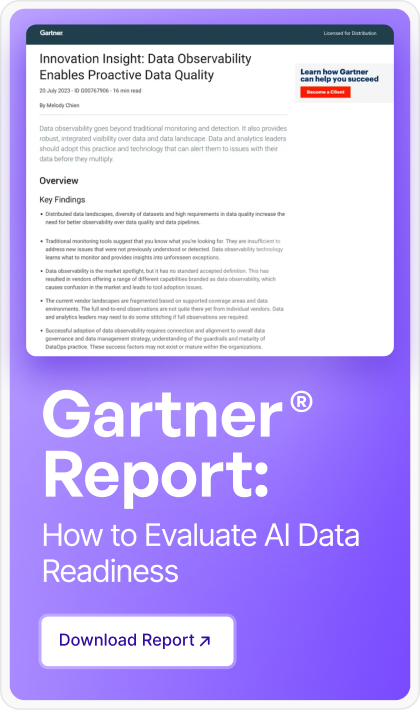The volume of data generated today in healthcare is nothing short of staggering. By 2025, the compound annual growth rate (CAGR) of healthcare data is projected to reach 36%, driven largely by electronic medical records (EMR), medical imaging, and a host of other healthcare technologies. This explosive growth shows the critical role that data plays in patient care, decision-making, and operational efficiency. However, this vast influx of data also brings significant challenges, particularly in maintaining data quality, which is vital for delivering accurate and reliable healthcare services.
High-quality data is crucial for effective healthcare delivery, enabling accurate diagnoses, appropriate treatments, and improved patient outcomes. It also ensures the smooth operation of healthcare facilities and compliance with regulatory requirements. Conversely, poor data quality can result in misdiagnoses, treatment errors, and inefficient processes, jeopardizing patient safety and increasing costs.
Healthcare organizations face myriad challenges in maintaining data quality, such as data silos that causes inconsistent formats and hinders analysis. Outdated technologies and healthcare data governance issues, such as unclear ownership or insufficient oversight, further complicate matters. Managing diverse data sources, from EMRs to patient-reported outcomes, compounds the need to protect privacy and comply with regulations.
Addressing these data quality concerns is essential for improving patient care and supporting advanced healthcare strategies. Quality data underpins population health management, personalized medicine, and other initiatives relying on accurate datasets.
This article explores common data quality issues in healthcare data management and effective strategies to address them.
Common Data Quality Concerns in Healthcare Data Management
Every industry faces its own data quality challenges. The following are particularly important to healthcare:
1. Inaccurate data entry
Inaccurate data entry due to human error, miscommunication, or outdated data entry methods can result in serious consequences, such as misdiagnoses, incorrect treatments, and billing errors. For instance, if a patient’s allergy is incorrectly recorded, it could lead to a severe allergic reaction, compromising patient safety and care quality.
2. Inconsistent data formats
When healthcare data is recorded in inconsistent structures or units, it hinders data interoperability, making it difficult to share and analyze information accurately. For example, if blood pressure readings were recorded in both mmHg and kPa, it would confuse healthcare personnel and potentially lead to incorrect clinical decisions.
3. Missing data
Completely or partially absent data due to human or system errors can lead to incomplete patient histories, impacting clinical decision-making and care. For example, incomplete medication history may lead to harmful drug interactions.
4. Duplicate records
Duplicate records are common in most industries. But in healthcare, the impact can be catastrophic. For example, if a patient’s information is recorded multiple times, whether due to variations in name spelling or data-entry errors, it can lead to redundant tests or conflicting treatment plans.
5. Outdated information
Outdated records may lead to inappropriate treatments and missed preventive care opportunities. For example, if a patient’s address or contact detail isn't updated, they may miss important appointment reminders, resulting in delayed care or potential health risks.
6. Impact on clinical trials and research
Poor data quality significantly affects clinical trials and research, leading to flawed outcomes and wasted resources. Inaccurate or incomplete data can skew results, invalidate findings, and lead to incorrect conclusions, undermining the effectiveness of medical research and delaying advancements in healthcare.
Five Ways to Address Data Quality Concerns in Healthcare
1. Adopt electronic healthcare records
Electronic health record (EHR) systems store comprehensive patient information, including medical history, treatment plans, and billing details. They streamline data entry, significantly reducing manual errors and ensuring consistent data capture across the healthcare organization — vital for accurate diagnoses, effective treatment plans, and seamless communication between healthcare providers.
EHR integrates multiple aspects of patient care into a unified platform. A study published in the Journal of the American Medical Informatics Association found that EHR systems significantly reduced adverse drug events in hospitals. In addition to lowering the likelihood of data errors, EHR improves the overall accuracy and accessibility of patient data, leading to better patient outcomes and more efficient healthcare delivery.
2. Standardize data formats and codes
Standardizing data formats and codes ensures uniformity, elevating data quality and making it easier to share and analyze critical patient information. Consistent data formats and standardized coding systems (such as ICD-10 for diagnoses and LOINC for laboratory tests) improve data accuracy and facilitate smooth data exchange between different systems and providers.
3. Implement real-time data validation
Real-time data validation flags errors before they can cause harm or confusion. In healthcare, where every piece of data can significantly impact patient outcomes, accurate data can literally mean the difference between life and death. Real-time data validation acts as a gatekeeper, checking for errors, inconsistencies, or missing information as soon as the data is entered.
Acceldata's integrated validation immediately rules flag discrepancies — such as mismatches in patient ID numbers, missing required fields, or an entry that doesn’t meet predefined standards. Catching data errors at the point of patient check-in saves time and resources that may otherwise be spent on manual data cleaning or correcting errors down the line.
In an environment like healthcare, where decisions are often made in real time, ensuring the accuracy of data at the point of entry is a necessity. Real-time data validation keeps data clean, reliable, and ready to support accurate patient care from the moment it’s collected.
4. Deploy automated data-cleansing tools
Data accumulates at a rapid pace in busy healthcare settings. Regular cleansing helps prevent “data waste,” defined as errors, duplicates, and inconsistencies that can clutter the system and lead to poor decision-making.
Automated data cleansing tools act as diligent custodians, working behind the scenes to identify and correct issues without manual intervention. They automatically detect and rectify errors, merge duplicate records, and address inconsistencies, ensuring accurate and usable data.
Modern data cleansing tools can automatically merge duplicate patient records, correct inaccuracies, and standardize formats across large datasets. Automating this process saves time and reduces the risk of human error, allowing healthcare providers to focus on what they do best — caring for patients.
5. Utilize machine learning for data anomaly detection
Utilizing machine learning for data anomaly detection is a powerful approach to enhancing data quality in healthcare. Unlike traditional manual methods, machine learning algorithms can analyze vast amounts of data quickly and accurately, identifying unusual patterns or errors that might otherwise go unnoticed. This capability is crucial in a field where even minor data inconsistencies can lead to significant consequences.
Machine learning models detect data anomalies by continuously learning from the data they process. For example, a healthcare organization might implement machine learning algorithms to analyze patient records and billing information, flagging inconsistencies or outliers for further review. This proactive approach helps catch errors early, improving the accuracy and reliability of healthcare data.
Acceldata Torch leverages machine learning to monitor and enhance data quality across multiple sources. It empowers organizations to automatically provide data asset profiles, generate data quality rules, detect and rectify anomalies, ensuring that their data remains consistent, accurate, and trustworthy.
Incorporating machine learning for anomaly detection streamlines the process of maintaining data integrity in healthcare. It significantly reduces the risk of errors, leading to better patient outcomes and more efficient healthcare operations.
Key Takeaways
Data quality is the foundation of effective healthcare delivery, directly influencing patient outcomes, operational efficiency, and compliance with regulatory standards. Inaccuracies, inconsistencies, and missing healthcare data can lead to significant risks, such as misdiagnoses, incorrect treatments, and unnecessary costs. By adopting advanced technologies and best practices, healthcare organizations can continue to enhance the quality of their data, ultimately leading to better patient outcomes and more efficient, and effective healthcare systems.
Advanced tools like Acceldata enable healthcare organizations to proactively manage data quality, ensuring that data is reliable and ready to support critical healthcare functions. This improves patient outcomes and enhances the overall efficiency and effectiveness of healthcare systems.
Schedule a demo of Acceldata to discover how its advanced tools can help you improve efficiency, optimize data quality, and improve patient care in your environment.
Summary
Healthcare data quality is crucial for accurate diagnoses, effective treatments, and operational efficiency, but it faces challenges like inaccurate data entry, inconsistent formats, and missing information. To address these issues, strategies such as adopting electronic health records, standardizing data formats, real-time validation, automated data cleansing, and machine learning can significantly enhance data accuracy and reliability. Improving data quality ultimately leads to better patient outcomes and more efficient healthcare systems.
Frequently Asked Questions (FAQs)
1. Why is poor data quality a serious risk in healthcare systems?
Poor data quality in healthcare can directly affect patient safety. Inaccurate, outdated, or duplicate records can lead to misdiagnoses, incorrect treatments, billing errors, and non-compliance with healthcare regulations. These issues not only harm patients but also increase operational costs, delay care, and damage trust in healthcare systems.
2. What are the biggest challenges healthcare organizations face in managing data quality?
The main challenges include:
- Inaccurate or incomplete patient records
- Duplicate entries due to manual data entry errors
- Outdated contact or treatment information
- Inconsistent data formats across systems
- Lack of real-time validation
These problems often arise from siloed systems, inconsistent standards, and outdated technologies.
3. How can AI help healthcare providers maintain clean and reliable data?
AI can continuously monitor healthcare data for anomalies, inconsistencies, and duplicates. It flags errors in real time and can even auto-correct certain issues. AI also helps validate patient information at entry points—like check-ins or lab results—reducing risks of human error and improving both data integrity and patient safety.
4. What is Agentic AI, and how does it support healthcare data quality?
Agentic AI refers to autonomous AI systems—or “agents”—that not only detect data quality issues but also take intelligent action. In healthcare, **Agentic AI can:
- Identify expired or duplicate patient records
- Suggest corrective actions
- Automate root cause analysis
This helps teams respond faster, reduce manual workloads, and maintain regulatory compliance.
5. How does Acceldata’s Agentic Data Management help healthcare organizations improve data quality?
Acceldata’s Agentic Data Management platform uses AI-powered data quality agents that:
- Automatically scan for anomalies in healthcare datasets
- Validate critical patient and billing information
- Standardize formats and flag inconsistencies
- Generate alerts and even trigger corrective workflows
This reduces risk, saves time, and ensures data is trustworthy and usable for clinical and operational decision-making.
6. How can missing or outdated patient information be prevented in healthcare systems?
You can prevent missing or outdated information by:
- Using real-time data validation tools at the point of entry
- Enabling alerts for stale data
- Standardizing EHR entries
Platforms like Acceldata monitor data freshness and notify teams when key updates—like new lab results or address changes—are missing or overdue.
7. What are the risks of duplicate patient records in healthcare, and how can they be managed?
Duplicate patient records can lead to dangerous outcomes like repeated tests, missed allergies, or conflicting treatment plans. Automated data-cleansing tools and machine learning algorithms can match and merge duplicates, ensuring a unified and accurate patient profile. Acceldata’s AI agents specialize in spotting these patterns early before they cause harm.
8. How can healthcare data teams use machine learning to detect anomalies in patient records?
Machine learning models can analyze millions of records to detect unusual patterns, such as:
- A sudden spike in medication errors
- Inconsistent lab result entries
- Misaligned patient IDs
Acceldata uses ML-driven anomaly detection to surface these insights in real time, helping healthcare teams take corrective action before issues escalate.
9. How do automated data cleansing tools benefit hospitals and clinics?
Automated data cleansing tools reduce the burden of manual corrections by:
- Merging duplicates
- Standardizing inconsistent formats
- Fixing incomplete fields
For healthcare providers, this means cleaner data, faster access to patient information, and fewer delays in treatment or billing—all of which enhance both patient care and staff productivity.
10. Can improving healthcare data quality reduce compliance risks and audit failures?
Yes, absolutely. Clean, well-governed data ensures alignment with regulations like HIPAA, HITECH, and CMS standards. Acceldata provides audit-ready dashboards, data lineage tracking, and real-time quality monitoring, helping healthcare organizations stay compliant and avoid fines, reputational damage, or operational setbacks.














.webp)
.webp)


